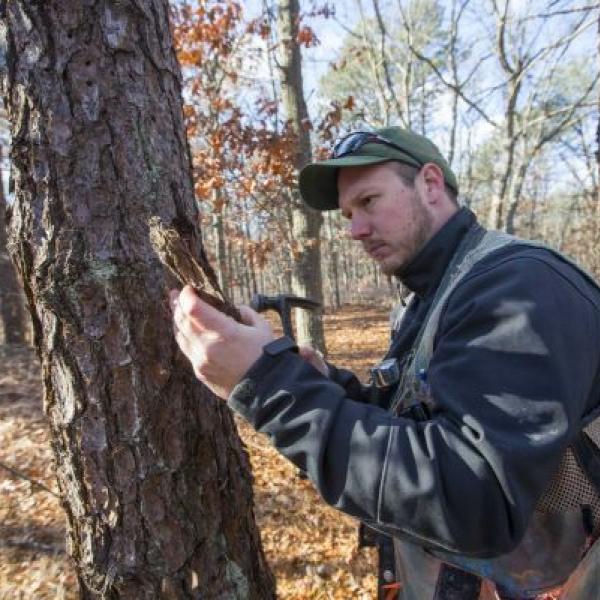
News Source
A beetle that has killed thousands of acres of pines across the nation has infested much more of Long Island than previously thought, and state officials want to cut down trees in an effort to stop the spread of the pest before winter ends.
The southern pine beetle, first confirmed on Long Island in the fall, now has been found in an array of federal, state, county, town and private lands within Suffolk County, according to the state Department of Environmental Conservation. Previously, the beetle had been verified in just seven parks and preserves on Long Island.
"We have a full-blown infestation," DEC regional forester John Wernet said. "When we first found the beetle, we thought it was just three or four sites. And we're finding more and more."
More coverageLong Island environmental stories
More than a dozen other locations where the beetle was spotted were discussed at a meeting the state agency held with government officials and nonprofit leaders Jan. 23.
While the beetle attacks all pines, its preferred victim is the pitch pine, which makes up most of Long Island's protected pine barrens. Swarms of beetles can kill a tree within two to four months.
In addition to the seven known spots, the pest has since been verified in the Sunken Forest and the William Floyd Estate in the Fire Island National Seashore, the Oak Brush Plains State Preserve at Edgewood, the Sayville National Wildlife Refuge in West Sayville, Napeague State Park in Amagansett, Munn's Pond County Park in Hampton Bays, Lakeland County Park in Islandia, Southaven County Park in Brookhaven, Cathedral Pines County Park in Middle Island, Sears Bellows County Park in Hampton Bays, Hubbard County Park in Flanders, Hidden Pond Park and part of the Holbrook Country Club in Islip Town, and several privately owned parcels in Suffolk County.
In all, more than 1,000 acres of pine stands on Long Island are infested, Wernet said.
A Southern Pine beetle is shown in this photo from the New York State Department of Environmental Conservation. The invasive insect is threatening pine trees on Long Island's south shore.
"The beetle has the potential to devastate tens of thousands of acres of publicly owned parkland," said Peter Scully, director of DEC Region 1, which covers Long Island.
Disrupting the migration
A pitch pine tree at the Wertheim National Wildlife Refuge in Shirley on Oct. 29, 2014 shows pitch tubes, or nodes of tree sap, which is a sign of the presence of the Southern Pine Beetle. The beetle species burrows into the bark and can be seen as the small black speck on top of the sap.
The beetle kills trees by burrowing through the bark, overwhelming the tree's defenses through sheer numbers before flying to the next one.
The beetles can be slowed by cutting down infested and dying trees, thinning forests and using prescribed fires, Wernet said. Pesticides also are a possibility, said Robert Marsh, DEC natural-resources supervisor, but they're expensive and don't always solve the problem.
Wernet said his agency hopes to begin cutting infested trees at Henry's Hollow Pine Barrens State Forest early this month. That infestation -- the largest on state DEC land -- threatens the adjacent David A. Sarnoff Pine Barrens Preserve, which so far is beetle-free.
"If you don't take action, you could lose thousands of acres of pine barrens forest," Scully said. "The point is to stop it before it gets to Sarnoff."
Infested trees already were felled at Belmont Lake State Park, where state officials said the beetle has been halted, and at Sayville National Wildlife Refuge, where about 40 trees were found to be infested.
The Fire Island National Seashore received an $80,000 emergency grant to mark and cut infested trees on its land, and tagging of infested trees should begin this week, park biologist Jordan Raphael said.
The beetle has attacked the pitch pines in the western section of the critically imperiled Sunken Forest -- one of only two such ecosystems in the world -- and park managers are worried the pests could infest the historic white pines planted by the William Floyd family on their Mastic Beach estate in the 1800s, he said.
Michelle Potter, refuge manager of the Long Island Complex of the U.S. Fish and Wildlife Service, said her agency was looking at cutting 400 to 500 trees at Wertheim National Wildlife Refuge in Shirley, where about 200 acres were found to be infested.
Experts said it was preferable to cut down infested trees during the winter, when the beetles are dormant. In warmer months, a 50- to 60-foot buffer of healthy trees also must be cut to keep the beetles from flying farther into the forest.
Unsure how, but here now
It is unknown exactly how the beetle got to Long Island, but it's possible that the pest is another unwelcome legacy of superstorm Sandy. Marsh said it could have arrived here on a storm's strong winds, or it could have hitched a ride on out-of-state trucks that came to Long Island for storm-recovery work.
"At this stage it's going to be very difficult this far down the road to try and figure out how it got here," Marsh said.
On one thing, experts agree: The beetle is here to stay.
"The presence of the southern pine beetle we now know is not an incident, like a storm or a fire or anything like that," Scully said. "It's going to be with us. It can't be eradicated."
FACTS ABOUT THE BEETLE
* About the size of a grain of rice
* Feeds on all species of pine trees
* Swarms can kill a tree within two to four months
* The DEC asks anyone who thinks they have seen pine trees infested with southern pine beetles to call the DEC's Forest Health Information Line at 866-640-0652 or email the DEC at foresthealth@dec.ny.gov.